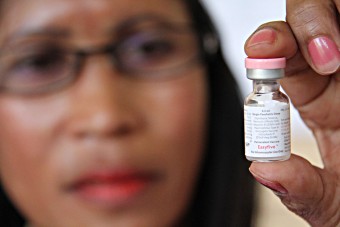
Clarette Raharimanjaka in Madagascar shows the pentavalent “Easy Five” a GAVI supported vaccine, at Befeletanana Maternity ward in Antananarivo.
25 July 2013 - New evidence carried out by 115 researchers, working in seven different countries over the course of eight years, provides fresh evidence of the impact of Haemophilus influenzae type b (Hib) vaccines on reducing the burden of disease.
Comprising of 13 articles, the research has been published together as the Hib Initiative Supplement in a GAVI sponsored special issue of The Journal of Pediatrics.
Asian and Eastern European countries
With almost all GAVI-eligible countries now using Hib vaccines, as part of the five-in-one pentavalent vaccines, the supplement provides answers to strategic questions that are best addressed following routine usage over time.
The research also provides countries with assurance that Hib vaccines have demonstrated impact, particularly in Asian and Eastern European countries where data was either not available, or interpretation of previous studies was unclear.
Mongolia, Mozambique
In Mongolia, for example, one of the earliest countries in Asia to introduce the Hib vaccine, Hib meningitis incidence decrease from 28 cases per 100,000 children in 2005 to just two per 100,000 by 2010. This contributed to an overall reduction in meningitis incidence, despite increases in other types of meningitis.
And in Mozambique a lasting impact was demonstrated, in spite of high HIV prevalence.
Cost effectiveness of pentavalent vaccine
The supplement also includes a study co-authored by Dr Hope Johnson, formerly at Johns Hopkins Bloomberg School of Public Health but now GAVI’s Head of Programming Outcomes and Impacts, estimating the cost effectiveness of pentavalent vaccine across a variety of scenarios at the state level.
It also demonstrated that the vaccine is highly cost effective, particularly where disease burden is higher and access to care lower.
Eliminated
Prior to widespread vaccine use, Hib was the most common cause of bacterial meningitis and an important cause of severe pneumonia in children under five years old worldwide. Today, thanks in large part to vaccines, the disease has been virtually eliminated in many high-income countries and significantly reduced in low-income countries.
However although Hib conjugate vaccines have been widely used in high-income countries since the 1990s, their uptake has been much slower in developing countries. This is due to multiple barriers, but in particular a lack of local data on disease burden and a lack of awareness of the potential impact of vaccines.

Clarette Raharimanjaka in Madagascar shows the pentavalent “Easy Five” a GAVI supported vaccine, at Befeletanana Maternity ward in Antananarivo.
25 July 2013 - New evidence carried out by 115 researchers, working in seven different countries over the course of eight years, provides fresh evidence of the impact of Haemophilus influenzae type b (Hib) vaccines on reducing the burden of disease.
Comprising of 13 articles, the research has been published together as the Hib Initiative Supplement in a GAVI sponsored special issue of The Journal of Pediatrics.
Asian and Eastern European countries
With almost all GAVI-eligible countries now using Hib vaccines, as part of the five-in-one pentavalent vaccines, the supplement provides answers to strategic questions that are best addressed following routine usage over time.
The research also provides countries with assurance that Hib vaccines have demonstrated impact, particularly in Asian and Eastern European countries where data was either not available, or interpretation of previous studies was unclear.
Mongolia, Mozambique
In Mongolia, for example, one of the earliest countries in Asia to introduce the Hib vaccine, Hib meningitis incidence decrease from 28 cases per 100,000 children in 2005 to just two per 100,000 by 2010. This contributed to an overall reduction in meningitis incidence, despite increases in other types of meningitis.
And in Mozambique a lasting impact was demonstrated, in spite of high HIV prevalence.
Cost effectiveness of pentavalent vaccine
The supplement also includes a study co-authored by Dr Hope Johnson, formerly at Johns Hopkins Bloomberg School of Public Health but now GAVI’s Head of Programming Outcomes and Impacts, estimating the cost effectiveness of pentavalent vaccine across a variety of scenarios at the state level.
It also demonstrated that the vaccine is highly cost effective, particularly where disease burden is higher and access to care lower.
Eliminated
Prior to widespread vaccine use, Hib was the most common cause of bacterial meningitis and an important cause of severe pneumonia in children under five years old worldwide. Today, thanks in large part to vaccines, the disease has been virtually eliminated in many high-income countries and significantly reduced in low-income countries.
However although Hib conjugate vaccines have been widely used in high-income countries since the 1990s, their uptake has been much slower in developing countries. This is due to multiple barriers, but in particular a lack of local data on disease burden and a lack of awareness of the potential impact of vaccines.
